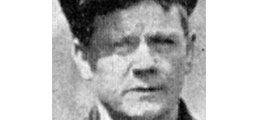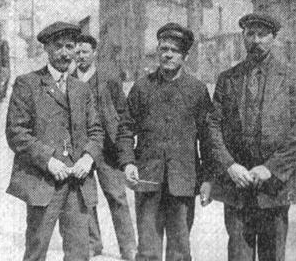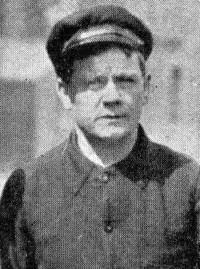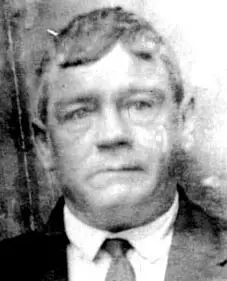Side Menu: The Mystery
George Francis McGough
Able Seaman

“Murdoch -God help me; don’t ask me what I saw.””
While George McGough as an exact name has yet to be found on a crew list (certainly not to be confused with Mr. James R. McGough, a first class businessman) there is the name “McGough, James (Paddy)” listed as a surviving member of the deck crew in Titanic & Her Sisters Olympic & Britannic (p.482 (3.) ) and Encyclopedia Titanica questions the possibility of a connection between the two names:
“Mr. George M. (?James R. “Paddy”) McGough of St. George's Street, Southampton was an able-bodied seaman on the Titanic. After helping at the davits with lifeboat 14 on the port side, McGough crossed over to the starboard side of the ship where he was assigned to lifeboat 9 and was rescued.” 3 (Philip Hind, Encyclopedia Titanica (8.))

McGough was one of the first three crew to walk
out of the docks at Plymouth the previous day,
when eager waiting journalists pounced, and
also took his picture. He is showed centre,
in a picture from the Daily Sketch.
Photograph: Senan Molony/ET(8.)
According to research by Senan Molony on Encyclopedia Titanica, McGough's name has been a cause of confusion, being misspelt and mispronounced, including it being listed as 'McGoff' in a White Star Line survivors list in Southampton 1912, he lied about his age (listing himself as 25 when we was actually 36) and interestingly he was one one of two known killers to have been aboard Titanic (the other Stoker William Mintram) and the only one that survived. Molony's research reveals that the Irishman, also known as "Paddy" killed a fellow crewman, a Welshman named John Dwyer, during a drunken fight about the Rustington while it was anchored off Santos, Brazil. He spent time in Winchester prison during 1900 for the crime. In regards to the boat McGough departed in, Molony reports: "AB George Francis McGough may possibly have been saved in boat 9 – but the problems adduced above, not least his own reported account, should give us careful pause. He may very well have been saved in another, later, boat." (8.)
A George “Paddy” McGough is quoted in the April 20, 1912 edition of The New York Evening World as saying:
“Both Captain Smith and Junior Chief Officer Murdoch were now together on the bridge, the water being up to their armpits. The next I saw of Captain Smith was in the water holding a child in his arms. He swam to the raft on which was Second Officer Lightoller and gave the child to the mate. That was the last. He and the ship went down, and Murdoch -God help me; don’t ask me what I saw.” (courtesy of Bill Wormstedt, Shots in the Dark (12.) )
It is interesting that Murdoch is referred to as “Junior Chief Officer” and then McGough says “God help me; don’t ask me what I saw” in regard to his last sighting of Murdoch, creating more intrigue than resolving it. As far as can be determined, McGough never revealed exactly what he saw that was so disturbing. Also, Lightoller never made mention of ever receiving a child from the Captain.

Mr George Francis McGough.
Photograph: Senan Molony/ET (8.)
(Click image to enlarge)
Needless to say, if McGough left in lifeboat No.9, as general consensus seems to agree, he was in no position to see either Smith of Murdoch or the events he describes and there is no evidence that Lightoller ever received a child from Smith in the water.
Curiously, Richard Edkins of the Dalbeattie Website uses McGough as a 'defence' witness as he believes that McGough describes what may have happened to Murdoch: “Mr. George McGough, a seaman “reported that he saw the sea surge up the deck towards the crew he was with, working to rig Collapsible A for launching from the No.1 lifeboat davits. Murdoch, then straightening the falls, waved to those about him to get further back up the tilting deck. The sea then engulfed them, and Collapsible A was left floating at the davits until it broke loose.” (Richard Edkins, Murdoch of the Titanic (1.))
I wrote to Mr. Edkins requesting further information and he replied: “There may have been two Goughs. I have received contradictory advice on mentioning Gough. Yet again, a matter up for amendment.” (e-mail 14/02/2000)

George McGough in 1920.
(Senan Molony/Southampton Archives) (8.)
If this evidence is to be taken as reliable (ie describing Murdoch as being engulfed in the sea) this does not necessarily indicate a cause of death and may have again been a generalisation rather than a specific description of Murdoch’s death, born out by the fact that according to the above quote from Encyclopedia Titanica, he made his escape aboard lifeboat No.9, well before Murdoch’s alleged suicide (the sea engulfing them would not necessarily explain the unpleasant sight regarding Murdoch that he refused to reveal either).
George Behe writes: “George McGough never testified at either Inquiry -- nor was he present on board the Titanic when Murdoch met his death; McGough had left the Titanic in boat #9 at 1:30 a.m.-- nearly an hour before Murdoch lost his life.” (11.)
Verdict: